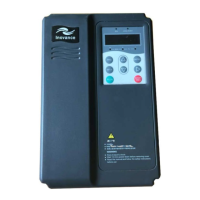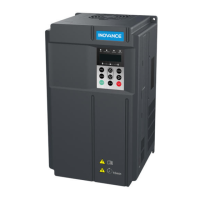This parameter is used to select the PID reference channel.
FA-03
PID action direction Factory default value 0
Setup range
0 Positive action
1 Reverse action
Positive action: When the feedback signal is higher than the PID reference, it needs to reduce
the output frequency of the inverter to balance the PID. The winding tension PID control is the
example.
Reverse action: When the feedback signal is higher than the PID reference, it needs to
increase the output frequency of the inverter to balance the PID. The unwinding tension PID
control is the example.
FA-04
PID reference feedback range Factory default value 1000
Setup range 0
~
65535
PID reference feedback range is a non-
dimensional unit. It is used to display the
PID reference an
FA-05
Proportional gain P Factory default value 20.0
Setup range 0.0
~
100.0
FA-06
Integration time l Factory default value 2.00s
Setup range 0.01s
~
10.00s
FA-07
Differential time D Factory default value 0.000s
Setup range 0.00
~
10.000
Proportional gain P: It decides the adjustment intensity of the whole PID regulator. The higher
the P is, more powerful the adjustment intensity is. When this parameter is 100, indicating the
deviation between PID feedback quantity and the reference quantity is 100%, the adjustment
amplitude of the PID regulator on the output frequency command is maximum frequency (the
integral and differential functions are neglected).
Integration time I: It decides the speed of PID regulator adjusting the deviation between the
PID feedback quantity and the reference quantity. Integration time is the time within which
the integration regulator (the proportional and differential functions are neglected) performs
continuous adjustment and the adjustment quantity reaches maximum frequency (F0-09) when
the deviation between the PID feedback quantity and reference quantity is 100%. The shorter
the integration time is, more powerful the adjustment intensity is.
Differential time D: It decides the intensity of PID regulator adjusting the change rate of
deviation between the PID feedback quantity and the reference quantity. Differential time is
the time within which if the feedback quantity changes 100%, the adjustment quantity reaches
maximum frequency (F0-09) (proportional and integral functions are neglected). The longer the
differential time is, more powerful the adjustment intensity is.

